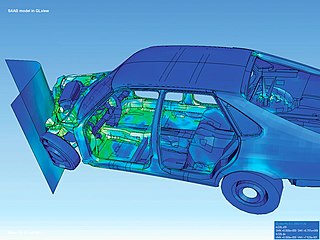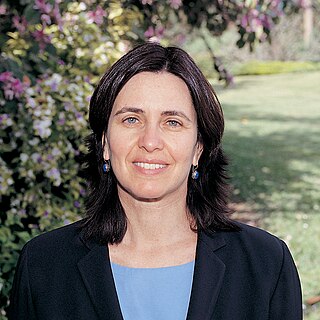Related Research Articles

Raytheon BBN is an American research and development company based in Cambridge, Massachusetts, United States.

Visualization, also known as Graphics Visualization, is any technique for creating images, diagrams, or animations to communicate a message. Visualization through visual imagery has been an effective way to communicate both abstract and concrete ideas since the dawn of humanity. from history include cave paintings, Egyptian hieroglyphs, Greek geometry, and Leonardo da Vinci's revolutionary methods of technical drawing for engineering purposes that actively involve scientific requirements.

Shafrira Goldwasser is an Israeli-American computer scientist. A winner of the Turing Award in 2012, she is the RSA Professor of Electrical Engineering and Computer Science at the Massachusetts Institute of Technology; a professor of mathematical sciences at the Weizmann Institute of Science; the director of the Simons Institute for the Theory of Computing at the University of California, Berkeley; and co-founder and chief scientist of Duality Technologies.
Scott J. Shenker is an American computer scientist, and professor of computer science at the University of California, Berkeley. He is also the leader of the Extensible Internet Group at the International Computer Science Institute in Berkeley, California.

Randal E. Bryant is an American computer scientist and academic noted for his research on formally verifying digital hardware and software. Bryant has been a faculty member at Carnegie Mellon University since 1984. He served as the Dean of the School of Computer Science (SCS) at Carnegie Mellon from 2004 to 2014. Dr. Bryant retired and became a Founders University Professor Emeritus on June 30, 2020.
James Hoe is a Taiwanese-American professor of Electrical and Computer Engineering at Carnegie Mellon University (CMU). He is interested in many aspects of computer architecture and digital hardware design, including the specific areas of field-programmable gate array (FPGA) architecture for computing; digital signal processor (DSP) hardware; and high-level hardware design and synthesis. Professor Hoe’s current research focus is on devising a new FPGA architecture for power efficient, high-performance computing. His research group is working on developing an FPGA runtime environment that incorporates partial reconfiguration, virtualization, and protection features to manage an FPGA as a dynamically sharable multitasking compute resource.
The Sidney Fernbach Award established in 1992 by the IEEE Computer Society, in memory of Sidney Fernbach, one of the pioneers in the development and application of high performance computers for the solution of large computational problems as the Division Chief for the Computation Division at Lawrence Livermore Laboratory from the late 1950s through the 1970s. A certificate and $2,000 are awarded for outstanding contributions in the application of high performance computers using innovative approaches. The nomination deadline is 1 July each year.

Danny Cohen was an Israeli-American computer scientist specializing in computer networking. He was involved in the ARPAnet project and helped develop various fundamental applications for the Internet. He was one of the key figures behind the separation of TCP and IP ; this allowed the later creation of UDP.
Sonic interaction design is the study and exploitation of sound as one of the principal channels conveying information, meaning, and aesthetic/emotional qualities in interactive contexts. Sonic interaction design is at the intersection of interaction design and sound and music computing. If interaction design is about designing objects people interact with, and such interactions are facilitated by computational means, in sonic interaction design, sound is mediating interaction either as a display of processes or as an input medium.
Ming C. Lin is an American computer scientist and a Barry Mersky and Capital One Endowed Professor at the University of Maryland, College Park, where she is also the former chair of the Department of Computer Science. Prior to moving to Maryland in 2018, Lin was the John R. & Louise S. Parker Distinguished Professor of Computer Science at the University of North Carolina at Chapel Hill.

Mohammad Salameh Obaidat is a Jordanian American Academic/ Computer Engineer/computer Scientist and Founding Dean of College of Computing and Informatics at the University of Sharjah, UAE. He is the Past President & Chair of Board of Directors of and a Fellow of the Society for Modeling and Simulation International (SCS), and a Fellow of the Institute of Electrical and Electronics Engineers (IEEE) for contributions to adaptive learning, pattern recognition and system simulation . He was born in Jordan to The Obaidat known Family. He is the cousin of the Former Prime Minister of Jordan, Ahmed Obaidat and received his M.S. and Ph.D. in computer engineering from the Ohio State University, Columbus, Ohio, USA. He is known for his contributions in the fields of cybersecurity, Biometrics-based Cybersecurity, wireless networks, modeling and simulation, AI/Data Analytics. He served as President and Char of Board of Directors of the Society for Modeling and Simulation International, SCS, a Tenured Professor & Chair of Department of Computer Science at Monmouth University, Tenured Professor & Chair of Department of computer and Information Sciences at Fordham University, USA, Dean of College of Engineering at Prince Sultan University, and Advisor to the President of Philadelphia University for Research, Development and IT. He has chaired numerous international conferences and has given numerous keynote speeches.
Sound and music computing (SMC) is a research field that studies the whole sound and music communication chain from a multidisciplinary point of view. By combining scientific, technological and artistic methodologies it aims at understanding, modeling and generating sound and music through computational approaches.
The Sound and Music Computing (SMC) Conference is the forum for international exchanges around the core interdisciplinary topics of Sound and Music Computing. The conference is held annually to facilitate the exchange of ideas in this field.
Squeaky hinges produce a squeaking or rasping noise when they are moved. Sounds can differ when opened or closed.

Albert Y. Zomaya is currently the Chair Professor of High Performance Computing & Networking and Australian Research Council Professorial Fellow in the School of Information Technologies, The University of Sydney. He is also the Director of the Centre for Distributed and High Performance Computing. He is currently the Editor in Chief of IEEE Transactions on Sustainable Computing and Springer's Scalable Computing and Communications. He was past Editor in Chief of the IEEE Transactions on Computers.
Georg Essl is an Austrian computer scientist and musician, who works in the areas of human-computer interaction, acoustics, mobile computing and mobile music. He is a visiting research professor at the College of Letters & Sciences at the University of Wisconsin–Milwaukee, and he is also affiliated with the Center for 21st Century Studies. Prior to that he was an assistant professor at the University of Michigan.
Joëlle Coutaz is a French computer scientist, specializing in human-computer interaction (HCI). Her career includes research in the fields of operating systems and HCI, as well as being a professor at the University of Grenoble. Coutaz is considered a pioneer in HCI in France, and in 2007, she was awarded membership to SIGCHI. She was also involved in organizing CHI conferences and was a member on the editorial board of ACM Transactions on Computer-Human Interaction.
Sound scenography is the process of staging spaces and environments through sound. It combines expertise from the fields of architecture, acoustics, communication, sound design and interaction design to convey artistic, historical, scientific, or commercial content or to establish atmospheres and moods.
Bin Yang is a professor of computer science the department of computer science, Aalborg University. His research interests include data management and machine learning.

Shlomo Dubnov is an American-Israeli computer music researcher and composer. He is a professor in the Music Department and Affiliate Professor in Computer Science and Engineering and a founding faculty of the Halıcıoğlu Data Science Institute in the University of California, San Diego, where he has been since 2003. He is the Director of the Center for Research in Entertainment and Learning (CREL) at UC San Diego's Qualcomm Institute.
References
- 1 2 "Stefania Serafin". Aalborg University's Research Portal. Retrieved April 27, 2020.
- ↑ "Dr. Stefania Serafin – ICAD2018" . Retrieved April 27, 2020.
- ↑ "Stefania Serafin | Department of Music". music.stanford.edu. Retrieved April 27, 2020.
- ↑ "Aalborg Universitet København".
- ↑ "Stefania Serafin Professor, Aalborg University Copenhagen". imi.aau.dk. Retrieved April 27, 2020.
- ↑ "SMC Board". www.smcnetwork.org. Retrieved April 27, 2020.
- ↑ "Nordic SMC – Nordic Sound and Music Computing Network, supported by Nordforsk" . Retrieved April 27, 2020.